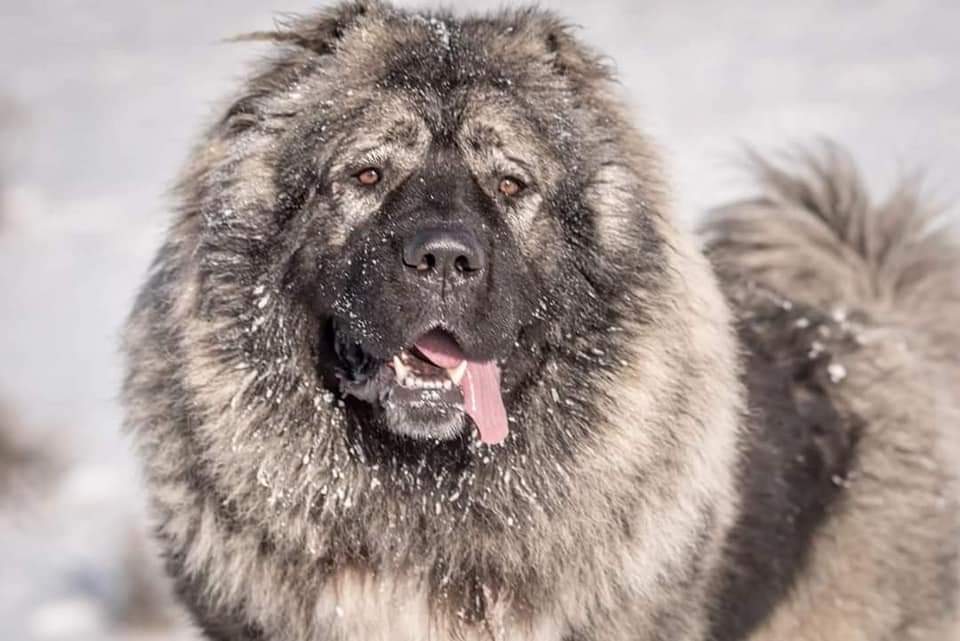
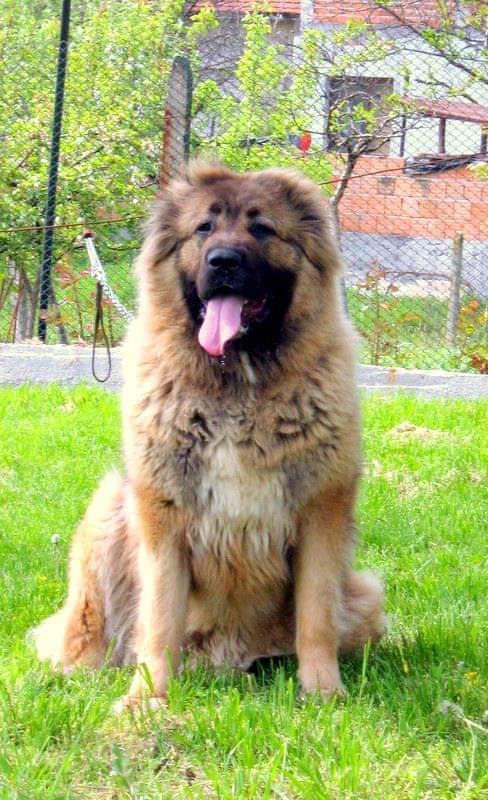
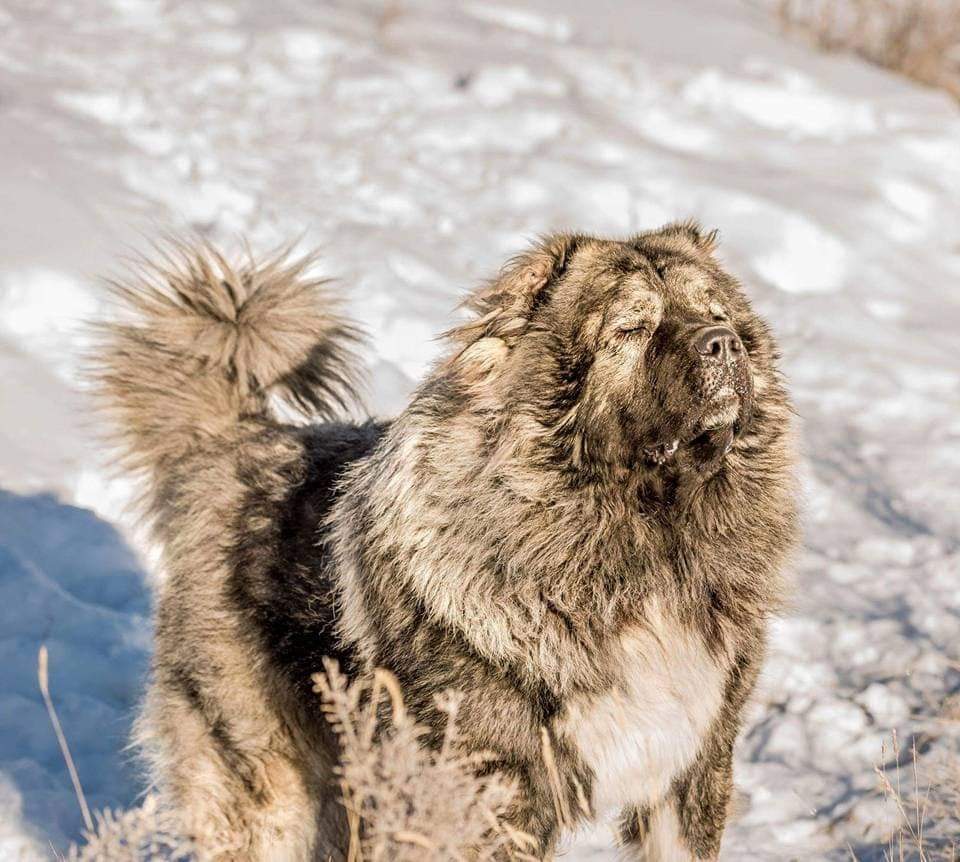
Four-legged friends accompany us all the time. They can be seen on ships and airplanes, pulling heavy sleds in Antarctica and saving people in danger every day. Some even conquer space. They live in the palaces of the rich, but also in the huts of the poor.
Dogs help us search for missing people and solve many crimes. Thanks to the loyal four-legged helpers, the police can find many illegal substances, because a dog has 10 times more olfactory cells than humans.
There are even dogs that were used as weapons in war, such as: B. Caucasian Shepherd Dog – so independent and brave!
Origin and history
Where does Caucasian Shepherd Dog originally come from?
Caucasian Shepherd Dog, also popularly called Caucasian Ovcharka, is one of the largest dogs whose homeland is the Caucasus. The age of the breed is approximately 2 – 2.5 thousand years. From the name of the breed it is clear that these dogs were used to protect flocks of sheep from wolves and other predators. In this regard, the animal had to have sufficient endurance, strength, courage, flair and thick fur so that it could work in the harshest weather conditions.
To date, there is no documented theory about the origin of the Caucasian Shepherd Dog.
The ancestors could be Tibetan mastiffs or Central Asian dogs. This is indicated by the external similarity of these breeds.
Caucasian Shepherd dogs also known as Caucasian ovcharka are believed to have been used in the army of the Armenian Emperor Tigran in the 1st century BC, where they distinguished themselves in battle against the Romans.
In the history of Caucasian Shepherd Dogs there were many difficult moments of development and the dogs were even threatened with complete extinction. It was a dangerous and unpredictable time. So e.g. B. during the Second World War, a sufficient number of purebred representatives of the Caucasian Shepherd died in service and many mixed with other breeds. Only thanks to the careful and long work of leading researchers, professors of cynology, this breed of dogs still exists today.
Until the end of the 19th century, the Caucasian Shepherd Dog was only known in the Caucasus and Russia. It was only in the 90s of the 20th century that the dog breed received worldwide recognition.
In 1990, the International Kennel Association – FCI registered the wolfhound as an independent breed.
Caucasian Shepherd Dog – Species
Living in different places with different natural and climatic conditions led to the emergence of four different intra-breed types.
Steppe type
The dogs of this type are very strong and large, but slim, long-legged and have a light coat. They emerged in dry and hot regions with an increased lack of water. These dogs were able to resist predators and had to accompany herds over long distances.
Mountain type
In the mountains, on the other hand, there was plenty of water, so the herds needed little exercise. Therefore, the mountain type was formed under the influence of these conditions. These particularly strong dogs have an elongated body, voluminous chest and a heavy head. The fur is very dense.
Two subspecies arose – Georgian and Azerbaijani.
Armenian guy
These dogs are similar to the mountainous type, but are smaller and have fewer bones. The head is square in shape and the fur is long and dense. The color is mainly brown or with white spots or a white collar. The dogs of this species are very hardy and unpretentious to living conditions. They have excellent protective properties and pronounced aggression towards outsiders.
Aboriginal Caucasian Shepherd Dog
This type was formed spontaneously and naturally. Dogs are hardy and remarkably adapted to climatic changes. They can be trained better and are people-oriented. Externally, these dogs are characterized by excellently developed muscles, an athletic build, a powerful neck, voluminous and rounded chest, a wide back, wide horizontal croup.
Caucasian Shepherd Dog – typical characteristics
Look
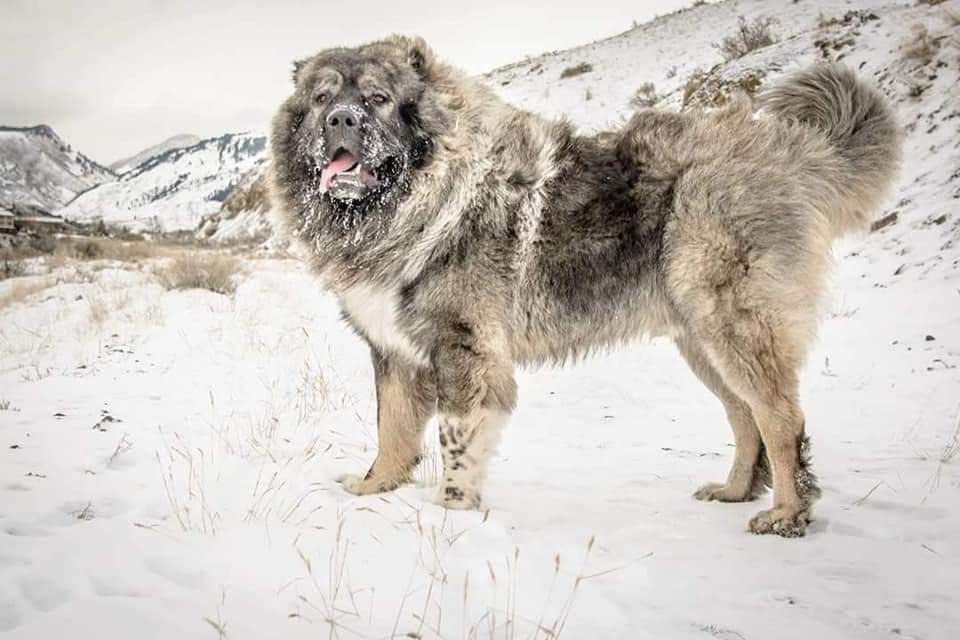
How big is a Caucasian Shepherd Dog?
Caucasian Shepherd Dog is a very large breed of dog overall.
The average size of the males varies between 70 – 77 cm, the average weight is 50 – 60 kg.
Females are slightly smaller, their height is about 65 – 70 cm and their weight –
45 – 50 kg. However, very large dogs can also be found, weighing more than 100 kg.
How old does a Caucasian Shepherd Dog live?
Relative to its size, Caucasian Shepherd Dog has a long life expectancy of 12 or even more years.
Caucasian Shepherd Dog is very strong and muscular. The head is very large and massive, with strong jaws. The skull is almost square. The forehead – wide, with a clearly visible furrow. The cheekbones are well defined. Eyebrow arches – weakly pronounced; the stop – not sharp. The eyes are round, small, set wide apart, of various colors – from dark brown to walnut, rarely green-gray; look serious and curious.
The snout is wedge-shaped. The bite can be scissor-shaped or straight.
The nose is large, mostly black. The lips are also with dark pigmentation.
Caucasian Shepherd Dog has 42 large, snow-white teeth.
The ears are set high and hanging. However, they are traditionally still completely docked.
The neck is very strong and short, is not carried high, approximately at an angle of 30 – 40 degrees to the back line; the neck is well developed.
The tail is sickle-shaped or curled at the end. In a calm state it hangs downwards. However, when the dog is excited, he will lift him over his back and sometimes roll him into a ring.
The limbs are muscular, strong, set parallel.
The bones are broad; all joints are well defined.
The paws are large, non-oval in shape, arched, with toes well placed together.
The skin is thick, elastic, with coarse, straight hair. The length of the fur is not less than 5 cm, and the colors are diverse. These dogs can be dark gray to light gray, but also reddish to blonde or even creamy white. It is not uncommon to find a black mask on the head or white spots on the body.
According to the hair coat, there are three types:
- Long-haired – Hair on the head and front legs is shorter but thicker. Longer fur on the tail. Shaggy “tassels” also form on the ears, a “mane” on the neck, and “pants” on the top of the hind limbs.
- Short-haired – the hair is short but thick, without a mane or flagtail.
- Mixed type – elongated hair, but without a mane and bushy tail.
Essence and character
Caucasian Shepherd Dog is peaceful when left untouched. That’s why some people perceive him as a huge and cute teddy bear. Others, on the other hand, are very afraid of this dog, which basically needs a strong owner. Only when the dog owner proves several times that he is the leader can the dog recognize and respect human leadership.
Caucasian Shepherd Dog is the perfect guardian. He is adapted to harsh conditions, hardy, confident and courageous, strong and balanced, very suspicious of strangers or animals. Because of their well-preserved protective instincts and threatening appearance, these dogs are often described as evil, so proper training is of great importance.
There are specimens that are quite aggressive. These are mostly males. If such a dog is angry, it will be very difficult to stop him. Only an experienced dog breeder can handle the training.
Caucasian Shepherd Dog is a loyal dog. They are characterized by their specific relationship with the owner and find it difficult to cope with a possible change of ownership. You are smart and independent. In a dangerous situation, they are able to make decisions independently to protect their owner.
Caucasian Shepherd Dog is hardy and prefers to spend time outdoors; needs more space, making it unsuitable as a city dog. The property should be fenced, otherwise the Caucasian Shepherd Dog will also consider the adjacent area as its territory and guard it.
These dogs are rational dogs. You will not see the Caucasian Shepherd dog constantly running around the garden and reacting to every noise. He will only respond if he realizes it is necessary.
Standard
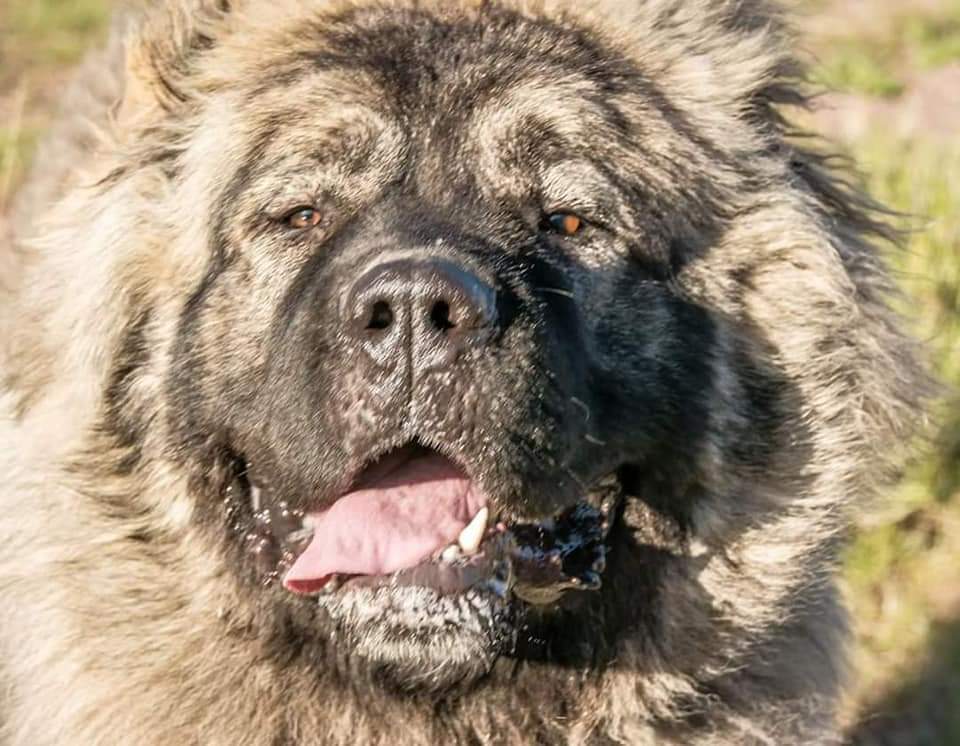
The first standard dates from 1932 and was compiled by V. L. Weißmann. This standard presents a comprehensive description of the Caucasian Shepherd Dog. Later, the standard of the famous Russian cynologist Mazover (1954) was in use for many years.
In 1976, another standard was published that describes each region of the dog’s body separately and immediately highlights the defects and errors of that region. However, this standard cannot provide a complete picture of the dog.
In 1984, the Caucasian Shepherd Dog was officially recognized as a dog breed by the FCI. The FCI lists the Caucasian Shepherd Dog under Standard 328 in Group 2: Pinscher and Schnauzer, Molosser, Swiss Mountain Dog.
Offspring
Caucasian Shepherd Dogs ideally become sexually mature and capable of reproduction at 2 years of age. This means that these dogs mature rather late. This is explained not only by the characteristics of the breed, but also by the fact that maturation means not only the ability to reproduce, but also the ability to protect oneself, the members of the herd and their territory, i.e. those inherent to it by nature and to do work intended for humans. So Caucasian Shepherd Dog must be both physiologically and mentally mature to successfully bear and raise a viable animal.
The little puppies have a great need to play. Through the game, the mutual understanding between dog and person improves, the skills and techniques that the dog later uses in real life are improved.
The period from about one month to five months is the best time for a puppy to get used to its future owner.
Feeding
Diet is the most important factor in a dog’s health.
Caucasian Shepherd Dog, the body has adapted to highly efficient absorption of any food, but especially with a high protein content. In their historic homeland, they ate protein-rich foods: scraps from sheep slaughter, stillborn and dead lambs.
In principle, the Caucasian Shepherd Dog has no requirements for its diet. He is undemanding.
The owners of such dogs should ensure balanced and regular feeding. Feed your four-legged friend fresh meat, some vegetables, fruit or rice twice a day! Raw meat or dry food are also possible. Only pork can be cooked.
The liver is rich in vitamins and is very useful especially for pregnant and lactating dogs.
The dairy products are especially necessary for puppies.
Fish products are also very healthy because they contain vitamins A, B and D, macro and micro elements as well as easily digestible fats.
It has been found that an adult dog needs an average of 50 kcal per 1kg of body weight daily when at rest. In summer, the daily energy requirement is reduced by 15%, but in winter it increases by 15%. During the mating season, the calorie content of food should be increased by 25%; from the second month of pregnancy it is increased by 50% and even more for the lactating bitch.
Peculiarities of digestion
Proteins, fats and carbohydrates undergo significant changes during the digestive process. Proteins break down into amino acids, carbohydrates into glucose, fats and fatty acids. These substances, absorbed into the blood and lymph, serve as both a source of energy and a building material for body tissues.
Digestion begins in the mouth. The intensity of the amount of saliva depends on the type of food consumed. Dry food uses a lot more saliva. And saliva itself is involved not only in digestion, but also in the dog’s health. Because of the important protein – lysozyme, saliva kills bacteria. The high content of this protein in saliva allows the dog to even eat carrion. This antibacterial effect of saliva is very important for the healing of wounds.
The acidity and digestive enzymes in the stomach are much higher than in humans.
Water requirements
An adult dog’s body normally contains about 65% water. Water determines the structure and biological properties of proteins, nucleic acids, lipids and the structure of cell membranes.
The sufficient amount of water in a dog’s body is one of the main conditions for normal activity. A dog can survive for weeks without food and only a few days without water.
Under normal conditions, the water requirement of an adult dog is 40 ml per 1kg of body weight daily. In young animals 2-3 times more.
An adult dog needs around 3 liters of water a day, of which around 1.5 liters comes from drinking water. The amount of drinking water required depends on the type of feed. So e.g. B. the drinking water requirement increases when using dry food.
To prevent diseases, it is necessary to adhere to the principle of healthy nutrition, give the dog enough exercise, timely vaccinations, carefully monitor its well-being and timely contact specialists to provide the necessary help.
Care
Dogs are stubborn and often difficult to care for. It is therefore recommended that you start caring for them when they are still puppies. This will help the puppies get used to regular care.
Whether the Caucasian is long or short-haired, grooming takes relatively little time. As a rule, brushing your dog twice a week is enough to remove dirt and dead hair.
Grooming also includes brushing ears and teeth. In addition, the claws must be trimmed regularly.
Summary about the Caucasian Ovcharka
Caucasian Shepherd Dog is one of the best and most loyal guard dogs in the world. He is not a teddy bear to play with, but a living creature that requires consistent upbringing, correct attitude and a friendly attitude towards himself. Caucasian Shepherd Dog will be loyal in the storm if you give your dog everything he needs like food, care, training and love.
Nothing in the world is perfect, and that includes the Caucasian Shepherd Dog. This dog was born under the sign of Sagittarius. Although some of them look like cuddly giants, they are very dangerous and very suspicious of strangers by nature. This breed is naturally very wary of strangers. This dog is not suitable for keeping in an urban environment. Don’t even think that a city apartment would be suitable for the Ovcharka. Training this dog is an absolute must. The Caucasian Shepherd Dog is not suitable for beginners.
If you want to ride your bike for hours, Caucasian Shepherd Dog is not the right companion. This dog doesn’t have a great need for exercise. The Caucasian dog does not need heating and can be kept in freezing temperatures without any problems.
She very rarely gets sick, so a vet is only needed in an emergency.
He is one of the best and most loyal guard dogs in the world.
Humans have given dogs qualities such as strength, courage, dignity, nobility, intelligence and beauty. You are no stranger to this breed of dog. It should not be forgotten that these faithful companions have accompanied man through the millennia, remaining his friends but never becoming his servants.
Certainly not each of us can raise such a dog, because the Caucasian Shepherd Dog is not a slave.
The German Shepherd is not easily pushed into the role of slave and will never allow himself to be mistreated.
But this dog will be able to protect its owner in the best possible way. Nobody can bribe him!
Read more interesting articles from yabaaa, such as: Kyrillisches Alphabet | Kyrillisch